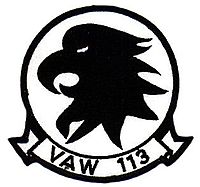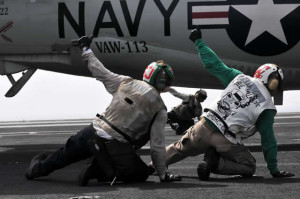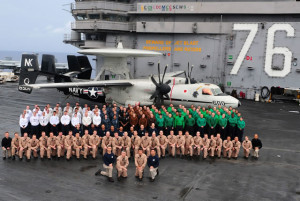http://www.cacclw.navy.mil/vaw113/history.html
HISTORY OF CARRIER AIRBORNE EARLY WARNING SQUADRON ONE ONE THREE
 BLACK EAGLES
BLACK EAGLES
The “Black Eagles” were commissioned as a separate squadron on April 20, 1967. One week later, VAW-113 deployed to the Western Pacific (WESTPAC) flying the E-2A “Hawkeye” aboard USS CONSTELLATION (CV 64). VAW-113 served in Vietnamese Operations every year from 1967 to 1975. The culmination of these efforts occurred in May 1975, when VAW-113 played a vital role in Operation FREQUENT WIND, the evacuation of American forces from South Vietnam.
 Since commissioning, the Black Eagles have made nineteen WESTPAC deployments. Tactical innovators, VAW-113 was the first E-2 squadron to operate with the F-14A and F-14D “Tomcat,” and the F/A-18 “Hornet,” providing substantial input to the tactical development and utilization of these platforms in the Outer Air Battle, Medium Range Anti-Air and overland arenas.
Since commissioning, the Black Eagles have made nineteen WESTPAC deployments. Tactical innovators, VAW-113 was the first E-2 squadron to operate with the F-14A and F-14D “Tomcat,” and the F/A-18 “Hornet,” providing substantial input to the tactical development and utilization of these platforms in the Outer Air Battle, Medium Range Anti-Air and overland arenas.
In 1987, the Black Eagles were recognized for operational excellence in their support of Battle Group DELTA and tanker escort operations in the North Arabian Sea/Gulf of Oman. In December of 1988, the Black Eagles set sail again for the North Arabian Sea, an underway period highlighted by monitoring tanker escort operations in support of Operation EARNEST WILL.
During their WESTPAC ’90 cruise, VAW-113 again deployed to the Gulf of Oman, providing both sea and air cover to Battle Group DELTA and allied forces in the Arabian Gulf as one of the first units deployed after the Iraqi invasion of Kuwait in August 1990. The Black Eagles spent over three months in the Gulf of Oman in support of Operation DESERT SHIELD prior to their return to San Diego in December of 1990.
In May of 1992, the Black Eagles and Carrier Air Wing FOURTEEN (CVW-14) took part in ROVING SANDS, the largest integrated air defense exercise in the continental United States. This was the first operational employment and successful test of the cutting edge technology incorporated in the E-2C Group II. Significant improvements in this aircraft over its predecessors are its APS-145 radar, Joint Tactical Information Distribution System (JTIDS), enhanced high speed processor (EHSP) computer, and Allison T56-A-427 engines.
 During the months of July-September of 1992, the Black Eagles deployed to Howard AFB, Panama in support of Joint Task Force Four (JTF-4), U. S. Counter-Narcotic (CN) operations. The Black Eagles received accolades from the Commander, JTF-4 for one of the most successful E-2C detachments on record for JTF-4 operations.
During the months of July-September of 1992, the Black Eagles deployed to Howard AFB, Panama in support of Joint Task Force Four (JTF-4), U. S. Counter-Narcotic (CN) operations. The Black Eagles received accolades from the Commander, JTF-4 for one of the most successful E-2C detachments on record for JTF-4 operations.
In August of 1994, VAW-113 again deployed to WESTPAC/Arabian Gulf, serving as an integral part of CVW-14 and Battle Group CHARLIE on board USS CARL VINSON (CVN 70). While in the Arabian Gulf supporting Operation SOUTHERN WATCH, VAW-113 aircrews acted as Navy Command and Control liaison officers in Saudi Arabia to Joint Task Force Southwest Asia, U.S. Air Force E-3A AWACS and RC-135 RIVET JOINT aircraft. During this historic first operational deployment of the E-2C Group II “Hawkeye”, the Black Eagles supported international relations by providing direct support and demonstration flights, in addition to static displays, for the Japanese Air Self Defense Force, the Republic of Singapore Navy and Air Force and the Royal Australian Air Force.
1995 saw the Black Eagles making a two month detachment to Roosevelt Roads, Puerto Rico supporting Joint Inter-Agency Task Force (JIATF) East’s war against drugs. The Black Eagles also became the first E-2C squadron to graduate a Weapons Tactics Instructor from the Marine Air Weapons Tactics Squadron course. Lessons learned helped to integrate the E-2C platform into roles of Direct Air Support Center-Airborne (DASC(A)), Tactical Air Control-Airborne (TAC(A)), and Airborne Battlefield Command, Control and Communications (ABCCC) platform. The squadron also made their second appearance at Roving Sands 1995. Cruising with USS CARL VINSON (CVN 70) in August 1995, the squadron witnessed history while participating in the celebration of the World War II 50th anniversary in Pearl Harbor, Hawaii. Fourteen WWII era aircraft, including three B-25s, two F-4Us, and a TBF Avenger were deck launched for the last time.
In May of 1996, the Black Eagles made their fifteenth WESTPAC deployment, aboard USS CARL VINSON. Operations DESERT STRIKE and SOUTHERN WATCH kept the Black Eagles busy during their time spent in the Arabian Gulf. Port visits along the way included Hong Kong, Singapore, and Tasmania.
The Black Eagles again deployed on WESTPAC in June of 1998, aboard USS ABRAHAM LINCOLN (CVN 72). The squadron’s departure marked the end of its basing at NAS Miramar. While on station in the Arabian Gulf, VAW-113 flew missions supporting Operation SOUTHERN WATCH. Port visits during the highly successful cruise included Hong Kong, Singapore, Jebel Ali, Perth, Hobart, and Hawaii. At the end of cruise, the Black Eagles launched from USS ABRAHAM LINCOLN, flying into their new home at Naval Base Ventura County – NAS Point Mugu, CA. VAW-113’s tactical prowess throughout the year was recognized by the Battle Efficiency “E” award for 1998.
 The squadron began WESTPAC 2000-01 on August 20, 2000 aboard the USS Abraham Lincoln. The main focus of the deployment was to conduct Operation Southern Watch (OSW) and to maintain economic sanctions against Iraq. The squadron received their fifth Battle Efficiency “E” for its outstanding work during the year 2000. In addition, the squadron earned the CNO’s Aviation Safety Award for E-2 squadrons. Finally, the Black Eagles received the Rear Admiral Frank Akers award for Airborne Early Warning excellence as the outstanding E-2 squadron in the entire Navy.
The squadron began WESTPAC 2000-01 on August 20, 2000 aboard the USS Abraham Lincoln. The main focus of the deployment was to conduct Operation Southern Watch (OSW) and to maintain economic sanctions against Iraq. The squadron received their fifth Battle Efficiency “E” for its outstanding work during the year 2000. In addition, the squadron earned the CNO’s Aviation Safety Award for E-2 squadrons. Finally, the Black Eagles received the Rear Admiral Frank Akers award for Airborne Early Warning excellence as the outstanding E-2 squadron in the entire Navy.
In 2003, VAW-113 found themselves on the way back to the Arabian Gulf to support, for a second time, Operation SOUTHERN WATCH. On the way home, the ship was turned around in Australia and sent back to the Gulf. The middle of March saw the beginning of Operation IRAQI FREEDOM with the Black Eagles at the tip of the spear. In April, the mission of the USS ABRAHAM LINCOLN BATTLE GROUP was complete and the Black Eagles were finally on their way home.
In May of 2004, the Black Eagles of VAW-113 deployed on board the USS JOHN C. STENNIS (CVN-74). The USS JOHN C. STENNIS CSG headed north and the Black Eagles were tasked with conducting the business of airborne command and control in the frigid waters of the Gulf of Alaska. Here the Black Eagles participated in NORTHERN EDGE. Operating jointly with Air Force and Navy assets, the Strike Group practiced Maritime Interdiction and Defensive Counter Air missions. During the last three weeks of July, the Black Eagles were able to enjoy the warmer climate of the Hawaiian Operating Area and participate in “Rim of the Pacific” Exercise. This multinational exercise reaffirmed U.S. alliances throughout the Pacific. Following this exercise, the JOHN C. STENNIS CSG joined up with the USS KITTY HAWK CSG for a Joint Air and Sea Exercise (JASEX.) This second annual joint exercise sprawled across the Pacific from the Sea of Japan to the South China Sea. The Carrier Strike Groups focused on the arduous duties of round the clock flight operations and battle space management. At times the JASEX had to be halted so each CSG could maneuver away from oncoming typhoons. In the end, the CSGs had to maneuver around seven storms and typhoons. In the final days of October 2004, the USS JOHN C STENNIS Carrier Strike Group returned to its homeport in San Diego, California.
In January of 2006, the Black Eagles, along with the CVW-14 and CSG-7 team, joined the USS RONALD REAGAN on its maiden voyage out of San Diego, CA. The Carrier Strike Group transited the Western Pacific to relieve the USS THEODORE ROOSEVELT Strike Group in the Arabian Gulf. In support of Operation Sea Dragon III, the Black Eagles paved the way for the future of the Hawkeye community as the first squadron to employ the new ALQ-217 ESM system. In addition, VAW-113 flew over 100 sorties, with a 99% combat sortie completion rate, in support of convoys on the ground during Operation Iraqi Freedom. On the way home, the USS RONALD REAGAN met up with the USS ABRAHAM LINCOLN and USS KITTY HAWK Strike Groups for the first ever OPERATION VALIANT SHIELD.
In January of 2007, the Black Eagles deployed on board USS RONALD REAGAN for SURGE WESTPAC 07. The Black Eagles took part in EXERCISE FOAL EAGLE while underway. This exercise included the participation of South Korea. The Black Eagles returned home in April of 2007. July of 2007 started the beginning of workups for the 2008 cruise.
 May of 2008 sent the Black Eagles on cruise once again in support of OPERATION ENDURING FREEDOM in Afghanistan. With a 98% mission completion rate and over 1,400 hours of mishap free flying, their performance was recognized with the Battle “E” award in early 2009. They returned just in time to have Thanksgiving dinner with their families in November 2008.
May of 2008 sent the Black Eagles on cruise once again in support of OPERATION ENDURING FREEDOM in Afghanistan. With a 98% mission completion rate and over 1,400 hours of mishap free flying, their performance was recognized with the Battle “E” award in early 2009. They returned just in time to have Thanksgiving dinner with their families in November 2008.
May 2009 saw the Black Eagles called upon to Surge in support of OPERATION ENDURING FREEDOM in Afghanistan after just 5 months of off-time. Living up to their own standard, the squadron continued in the 99th percentile for mission completion, having flown over 200 sorties successfully. Returning from Surge in October, over 20 Air Medals were awarded in recognition of the Black Eagles’ number of successful combat missions. To finish the year, VAW-113 was selected by the Commander of Naval Air Forces to receive the Battle “E” award for the second year in a row.
The operational tempo did not slow down for VAW-113 in 2010. They completed a work-ups cycle which included the multi-national RIMPAC exercise during the summer of 2010. In February of 2011, the Black Eagles deployed aboard the USS RONALD REAGAN in support of OPERATION NEW DAWN in Iraq and OPERATION ENDURING FREEDOM in Afghanistan. In March, during the transit across the Pacific, the Black Eagles were called into action following the devastating earthquake/tsunami in Japan. The Black Eagles provided the airborne command of the relief effort using their extremely capable Hawkeye 2000s in OPERATION TOMODACHI. Commander of Naval Air Forces awarded the squadron with their tenth Battle “E” Award for their efforts.
The Black Eagles are now passing their 50th anniversary with over 90,000 hours of Class A mishap free flights.
They have been awarded:
• the Joint Meritorious Unit Award
• three Meritorious Unit Commendation Medals
• ten Battle Efficiency “E”s
• one RADM Frank Akers Award
• two Chief of Naval Operations (CNO) Naval Aviation Safety Awards
• the Presidential Unit Citation
• the Navy Expeditionary Medal
• two South West Asia Service Medals
• four Armed Forces Expeditionary Medals
• two Sea Service Deployment Medals
• one Humanitarian Medal.
VAW-113 continues to distinguish itself as the premier Airborne Command and Control squadron in the Navy today.

